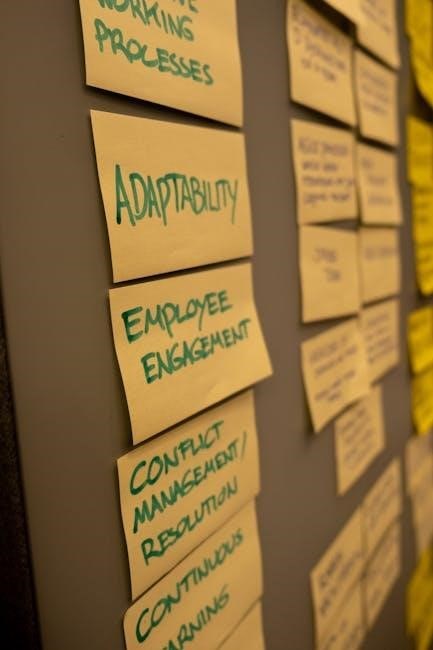
résolution de problème 1ère année pdf
Mastering problem-solving skills in the first year lays a strong foundation for mathematical thinking. It involves basic arithmetic‚ logical reasoning‚ and using visual aids to understand concepts. Resources like PDF worksheets and interactive tools support this journey‚ fostering independence and collaboration in young learners.
The Importance of Problem Solving in Early Education
Problem-solving is a cornerstone of early education‚ fostering critical thinking and logical reasoning. It helps students develop mathematical confidence and independence. By engaging with real-world scenarios‚ children learn to apply basic arithmetic and logical deduction to everyday challenges. Problem-solving also enhances collaboration and communication skills‚ as students often work in groups to find solutions. Early exposure to these skills builds a strong foundation for more complex math concepts in later years. Moreover‚ it encourages creativity and perseverance‚ essential for overcoming obstacles. With guided practice and interactive tools‚ young learners can master problem-solving techniques‚ setting them up for long-term academic success.
Basic Concepts and Skills Required
Problem-solving in the first year requires mastering basic math concepts like counting‚ addition‚ and subtraction. Students need to understand logical reasoning‚ such as identifying patterns and sequences. Essential skills include using numbers to solve real-world problems and applying arithmetic operations appropriately. Visual aids like tables and graphs help organize information‚ making it easier to find solutions. Additionally‚ students learn to break down problems into smaller‚ manageable parts and communicate their thinking clearly. These foundational skills build confidence and prepare learners for more complex challenges. Regular practice with exercises and interactive tools reinforces these abilities‚ ensuring a solid mathematical base for future learning.
Approaches to Teaching Problem Solving
Effective problem-solving instruction for first-year students involves guided discovery‚ where teachers encourage exploration and critical thinking. Modeling step-by-step approaches helps students understand systematic problem-solving. Encouraging peer collaboration fosters teamwork and communication. Integrating real-world scenarios makes learning relatable and engaging. Teachers should also incorporate visual aids and hands-on activities to cater to different learning styles. Positive reinforcement and constructive feedback build confidence and resilience. Differentiated instruction ensures all learners‚ including those with varying abilities‚ are supported. By combining these strategies‚ educators create a nurturing environment that promotes problem-solving proficiency and prepares students for future academic challenges.

Methods of Problem Solving
Problem solving involves analyzing situations‚ identifying patterns‚ and applying strategies like counting‚ logical reasoning‚ and constructive techniques to find solutions systematically and creatively.
Counting and Basic Arithmetic Problems
Counting and basic arithmetic are fundamental skills for first-year problem-solving. These skills help students understand numbers‚ sequences‚ and simple operations like addition and subtraction. Worksheets and activities often involve counting objects‚ identifying missing numbers‚ and solving basic equations. These exercises build a strong foundation for more complex math concepts. Teachers use manipulatives‚ such as blocks or counters‚ to make learning interactive and engaging. Real-world examples‚ like counting toys or sharing candies‚ make the problems relatable. Regular practice reinforces these skills‚ preparing students for advanced problem-solving in later years. These activities also improve hand-eye coordination and cognitive development‚ essential for overall academic success.

Logical Reasoning and Deduction
Logical reasoning and deduction are essential skills for first-year students‚ helping them develop critical thinking and problem-solving abilities. These skills involve analyzing information‚ identifying patterns‚ and making sound conclusions. Activities such as sorting objects‚ matching shapes‚ and solving simple puzzles encourage logical thinking. Deductive reasoning is introduced through questions like “If A is true‚ what does it mean for B?” Visual aids like Venn diagrams and flowcharts support understanding. Interactive games and story problems also enhance these skills‚ making learning engaging. By practicing logical reasoning‚ students improve their ability to approach problems methodically and confidently‚ laying a strong foundation for future academic challenges.
Constructive Problem Solving Techniques
Constructive problem-solving techniques involve breaking tasks into manageable steps‚ fostering creativity and critical thinking. For first-year students‚ methods like “Think‚ Plan‚ Do” encourage systematic approaches. Students learn to identify problems‚ brainstorm solutions‚ and evaluate outcomes. Visual tools‚ such as flowcharts and diagrams‚ help organize ideas. These techniques emphasize understanding the “why” behind solutions‚ not just the “how.” Real-world scenarios and hands-on activities make learning practical and engaging. By fostering collaboration and resilience‚ constructive problem-solving builds confidence and prepares students for more complex challenges. These skills are foundational for academic success and lifelong learning.
Using Tables and Visual Aids
Tables and visual aids are powerful tools for problem-solving in early education. They help students organize information‚ identify patterns‚ and make logical connections. For example‚ tables can be used to compare quantities or categorize objects‚ while charts and diagrams simplify complex concepts. Visual aids like number lines‚ shape sorters‚ and Venn diagrams are particularly effective for first-year students. These tools make abstract ideas concrete and engaging‚ fostering a deeper understanding of problem-solving processes. By incorporating visuals‚ teachers can cater to different learning styles‚ ensuring all students can grasp key concepts. Regular use of these aids enhances critical thinking and prepares students for more advanced problem-solving strategies in the future;

Resources for Problem Solving
Access to free PDF worksheets‚ interactive online tools‚ and visual learning techniques can significantly enhance problem-solving skills in first-year students. These resources provide structured exercises and engaging activities.
Free PDF Worksheets and Exercises
Free PDF worksheets and exercises are excellent resources for teaching problem-solving skills to first-year students. These materials are specifically designed for young learners‚ focusing on basic arithmetic‚ logical reasoning‚ and visual problem-solving. Many worksheets include colorful illustrations and engaging layouts to capture children’s attention. They often cover essential skills like counting‚ addition‚ subtraction‚ and simple logical deduction. Parents and educators can easily download these resources from educational websites‚ ensuring accessibility. The exercises are typically progressive‚ starting with simple tasks and gradually increasing in difficulty. This helps build confidence and reinforces foundational problem-solving abilities. Additionally‚ many PDFs include visual aids and step-by-step solutions‚ making them ideal for independent practice or classroom use.
Interactive Online Tools and Games
Interactive online tools and games are a dynamic way to introduce first-year students to problem-solving. These resources make learning engaging and fun‚ often incorporating animations and rewards to motivate young learners. Many platforms offer games that focus on counting‚ basic arithmetic‚ and logical reasoning. For example‚ matching games can help develop memory and deduction skills‚ while puzzles enhance spatial awareness. These tools are accessible on computers‚ tablets‚ or smartphones‚ making them versatile for both classroom and home use. They also provide immediate feedback‚ allowing students to track their progress and understand their mistakes. Interactive tools are particularly effective for visual and kinesthetic learners‚ as they combine movement and creativity with problem-solving tasks.
Visual Learning Techniques
Visual learning techniques are essential for first-year students‚ as they help bridge the gap between abstract concepts and concrete understanding. Using images‚ diagrams‚ and charts can make problem-solving more accessible and engaging. For example‚ visual aids like number lines or shape sorting activities can help students grasp basic arithmetic and spatial reasoning. Pictures and real-world examples also aid in breaking down complex problems into manageable parts. These techniques encourage students to organize their thoughts and identify patterns‚ fostering a deeper understanding of problem-solving processes. By integrating visual elements‚ educators can cater to students who learn best through sight‚ making lessons more effective and enjoyable.

Practice Exercises and Activities

Interactive exercises‚ hands-on tasks‚ and group activities help first-year students develop problem-solving skills through practical application and teamwork‚ enhancing their understanding and confidence in math concepts.
Simple Addition and Subtraction Problems
Simple addition and subtraction problems are foundational for first-year students‚ helping them build basic arithmetic skills. These exercises often involve single-digit numbers and real-world scenarios‚ such as counting objects or sharing items. PDF worksheets are widely used‚ offering structured practice with clear instructions and visual aids like number lines or blocks. Teachers and parents can create engaging activities‚ such as solving problems with physical counters or dice‚ to make learning interactive. Mastery of these skills is crucial for developing problem-solving confidence and a strong math foundation. Regular practice through fun‚ hands-on tasks ensures students grasp these concepts effectively and enjoy the learning process.
Real-World Application Scenarios
Real-world application scenarios are essential for helping first-year students connect problem-solving skills to everyday life. These scenarios often involve practical tasks‚ such as measuring ingredients for a recipe‚ counting money for small purchases‚ or organizing toys. PDF worksheets and interactive tools provide realistic contexts‚ making learning relatable and engaging. For example‚ a problem might involve planning a party with a limited number of guests or distributing candies equally among friends. Such activities not only enhance math skills but also encourage critical thinking and decision-making. Visual aids like charts or diagrams further support understanding‚ while group activities foster collaboration and communication. These scenarios prepare students to apply their skills confidently in real-life situations‚ bridging the gap between classroom learning and practical application.
Group Activities for Collaborative Learning
Group activities foster collaborative learning‚ encouraging students to work together to solve problems. These activities promote teamwork‚ communication‚ and mutual understanding. Examples include role-playing exercises‚ group puzzles‚ and interactive games that require collective problem-solving. For instance‚ students can collaborate to plan a pretend event or solve a simple community issue. Visual aids and games‚ often found in PDF worksheets‚ can be adapted for group use‚ enhancing engagement. Teachers can also create scenarios where students share ideas and strategies‚ building confidence and interpersonal skills. Collaborative learning not only strengthens problem-solving abilities but also prepares students for real-world teamwork experiences. These activities are particularly effective when aligned with visual learning techniques and practical applications.

Assessment and Feedback
Assessment involves tracking students’ progress in problem-solving skills through observation and informal checks. Correcting mistakes gently and providing constructive feedback helps build confidence and understanding. Regular feedback guides improvement.
Tracking Progress and Understanding
Tracking progress in problem-solving involves observing students’ ability to apply concepts and skills. Teachers use informal assessments‚ such as puzzles‚ math exercises‚ and logical games‚ to monitor development. Regular checks help identify strengths and areas needing improvement. Documenting progress through portfolios or checklists provides a clear record of growth. This approach ensures personalized feedback‚ allowing teachers to adapt instruction to meet individual needs. By observing how students tackle problems‚ educators can gauge their understanding and readiness for more complex challenges. This method fosters a growth mindset‚ encouraging students to view mistakes as learning opportunities. Consistent tracking helps build a strong foundation for future problem-solving skills.
Correcting Common Mistakes
Correcting common mistakes in problem-solving helps students build a strong foundation. Teachers identify frequent errors‚ such as impulsive answers or miscounting‚ and address them gently. Positive reinforcement is used to encourage a growth mindset. For example‚ if a student miscounts objects‚ the teacher guides them through the correct counting process. Visual aids and number lines are effective tools for clarification. Students are also taught to reflect on their mistakes‚ fostering self-correction. By breaking problems into smaller steps‚ teachers help students understand where they went wrong. This approach ensures misconceptions are addressed early‚ promoting confidence and accuracy in problem-solving. Parental involvement in practice also helps reinforce correct methods at home.
Encouraging Independent Practice

Encouraging independent practice in problem-solving is essential for building confidence and skills. Teachers provide simple‚ clear worksheets that match the student’s ability level; Games and interactive activities make practice enjoyable and engaging. Positive reinforcement is key‚ praising effort rather than just results. Students are encouraged to attempt problems on their own‚ using visual aids or manipulatives if needed. Regular‚ short practice sessions help develop a routine. Parents are also involved‚ receiving guidance on how to support independent practice at home. This fosters a sense of responsibility and prepares students for more complex challenges. By gradually increasing independence‚ students develop problem-solving skills and confidence in their abilities‚ laying a strong foundation for future learning.

Additional Resources
Find free PDF worksheets‚ interactive online games‚ and visual guides to support problem-solving skills. Explore platforms offering French-language resources tailored for first-year students.
Recommended Websites and Platforms
Several websites offer excellent resources for first-year problem-solving exercises in French. Education.com and SuperProf provide free PDF worksheets tailored for young students. For interactive learning‚ platforms like Khan Academy and Math Playground include games and visual aids. Additionally‚ French educational sites such as Éduscol and Cours-TIC offer curated materials specifically for first-grade problem-solving. These platforms cater to various learning styles‚ ensuring engagement and understanding. They often include printable guides and teacher-tested strategies‚ making them invaluable for both students and educators. Regularly updated content ensures relevance and alignment with curriculum goals.

Printable Worksheets and Guides
Printable worksheets and guides are essential tools for teaching problem-solving skills to first-year students. These resources often include step-by-step exercises‚ visual examples‚ and interactive activities designed to enhance understanding. Many worksheets focus on basic arithmetic‚ logical reasoning‚ and real-world application problems. They are typically available in PDF format‚ making them easy to download and print. Some guides also provide answers and teaching tips‚ helping educators track student progress. These materials are particularly useful for reinforcing concepts learned in class and encouraging independent practice at home. By using these printable resources‚ students can develop problem-solving confidence in a structured and engaging way.
Teacher-Tested Strategies
Teacher-tested strategies for teaching problem-solving skills to first-year students emphasize breaking down problems into manageable steps. Educators often use visual aids like diagrams and charts to simplify complex concepts. Incorporating real-world scenarios helps students connect abstract ideas to practical situations. Encouraging group work fosters collaboration and peer learning‚ while individual practice reinforces understanding. Teachers also recommend using games and puzzles to make problem-solving engaging. Providing immediate feedback and guiding students to reflect on their mistakes are key to improving their skills. These strategies‚ refined through classroom experience‚ ensure students develop a strong foundation in problem-solving during their first year.